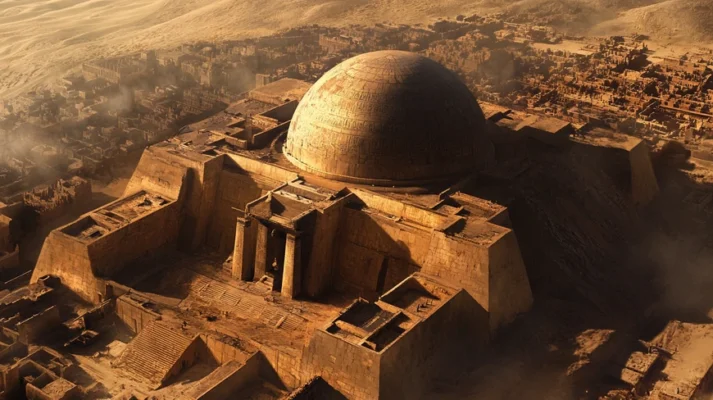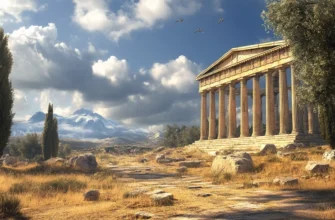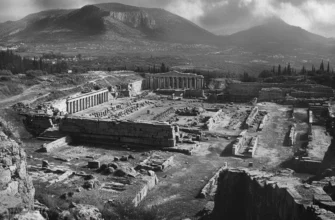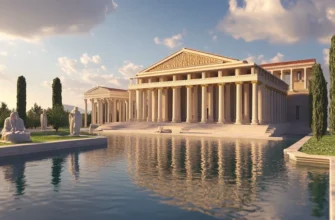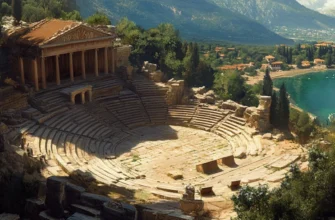Orchomenus was an ancient city in the region of Boeotia in modern-day Greece, which played an important role in the political, cultural, and religious life of the ancient world. It was one of the centers of the Mycenaean civilization in the 2nd millennium BC, competing for influence with cities such as Thebes.
According to myth, Orchomenos was founded by Minos or his descendants. The city became particularly famous under the rule of King Minyas, who, according to legend, was extremely wealthy. The famous Minyan tomb, also known as the “Treasury of Minyas,” was built in his honor — an impressive domed tomb similar to those built in Mycenae.
Archaeological excavations carried out since the 19th century have uncovered the remains of palaces, temples, and necropolises, confirming the city’s high level of development. In classical times, Orchomenos fell into decline but remained a religious center with temples dedicated to the goddess Demeter.
Today, the ruins of Orchomenos are a valuable historical monument that gives an idea of the grandeur and complexity of ancient Greek civilization.
Origin and early history
Orchomenos originated in prehistoric times and, according to legend, was founded by Minos or his descendants, linking the city to the Cretan-Mycenaean tradition.
Archaeological evidence suggests that the first settlements in the Orkhomen area appeared as early as the 3rd millennium BC, but the city reached its peak during the Late Bronze Age (c. 1600–1100 BC).
At that time, Orchomenos became an important political and commercial center in Boeotia, thanks to the fertile lands of the Kephis Valley and its convenient location. It is also known as one of the cities where an irrigation system was developed, which allowed the surrounding swamps to be drained and agricultural land to be expanded.
Already in the Mycenaean period, Orchomenos had a fortified palace, a complex burial system, and a high level of culture. The city was closely connected with Mycenae, as evidenced by tablets with Linear B inscriptions and numerous luxury items.
Orchomenos in the Classical and Hellenistic periods
In the Classical period (5th–4th centuries BC), Orchomenos lost its leading position to more powerful cities in Boeotia, particularly Thebes. Frequent political conflicts and participation in inter-city wars affected the city’s fate. Orchomenos opposed Theban hegemony, which led to several devastations — the destruction of the city by the Thebans in 364 BC is particularly well known.
However, by the Hellenistic period, Orchomenos had been rebuilt and partially regained its role as a regional center. Public buildings, theaters, temples, and fortifications reappeared in the city, indicating a gradual revival of political and cultural life.
Despite this, Orchomenos never regained its former glory of the Mycenaean period. With the beginning of Roman rule, it finally lost its significance as an autonomous entity, although it remained inhabited and was mentioned in the works of ancient authors, including Pausanias.
Archaeological sites
Orchomenos is one of the most important archaeological sites in Greece, thanks to its well-preserved monuments from the Mycenaean and later periods. Excavations carried out since the 19th century have uncovered numerous architectural structures, burials, and artifacts that give an idea of the city’s grandeur in ancient times.
The Treasury of Minyas
One of the most remarkable structures in Orchomenos is the so-called Treasury of Minyas, a large domed tomb built during the Mycenaean period. It is considered one of the greatest tholos tombs in Greece after the famous Treasury of Atreus in Mycenae.
The tomb has a round domed chamber with a diameter of over 14 meters, built of massive stone blocks. The entrance is decorated with exquisite reliefs and stone decorations, which testify to the high level of craftsmanship of the builders.
Significance and finds
Gold jewelry, pottery, weapons, and tablets with inscriptions in Linear B script were found in the tomb and adjacent burials. These finds confirm the wealth and importance of Orchomenos during the Mycenaean period.
Ruins of the theater and other buildings
During the Hellenistic period, a stone theater was built in Orchomenos, which was used for performances and public gatherings. Its remains have survived to this day and give an idea of the cultural life of the city in later centuries. The remains of temples, public buildings, and parts of the city walls have also been discovered.
The Treasury of Minyas
The Treasury of Minyas is one of the most remarkable architectural monuments of Orchomenos, dating back to the Mycenaean era (c. 14th–13th centuries BC). It is a monumental tomb that impresses with its size, architectural perfection, and preservation.
The tomb is named after the legendary king Minyas, who, according to legend, ruled Orchomenos and was famous for his incredible wealth. His name later became a symbol of luxury and power.
The tomb has a classic tholos shape — a round domed chamber built from precisely cut stone blocks that gradually narrow upward, forming a perfect dome without the use of mortar. The dome hall is over 14 meters in diameter and approximately 13 meters high, making it one of the largest in Greece. The long corridor (dromos) leading to the entrance was decorated with slabs and reliefs.
During excavations in and around the tomb, numerous valuable artifacts were found: gold jewelry, Mycenaean pottery, tools, weapons, and tablets with inscriptions in Linear B script. These items confirm the high status of the person buried here and at the same time indicate the close ties between Orchomenos and other centers of Mycenaean civilization.
The Minya Treasury is not only an exceptional example of Mycenaean architecture, but also an important source of knowledge about the social structure, burial traditions, and artistic tastes of the ancient inhabitants of Orchomenos. It is considered an archaeological treasure of global importance and is one of the key sites for studying the Late Bronze Age in Greece.
Architectural features
The Minos Treasure House is one of the most impressive architectural monuments of the Mycenaean era, demonstrating the high skill of ancient builders. It is a classic example of a tholos tomb, a type of burial structure characteristic of the Late Bronze Age.
The main architectural feature is a round dome built of massive stone blocks that gradually narrow at the top, forming a kind of pyramidal shape. This technology of building domes without the use of mortar was known only within the Mycenaean civilization and was an important engineering achievement of that time.
The dome has a diameter of about 14 meters and a height of over 13 meters, making it one of the largest in Greece. The technique of “gradually decreasing blocks” allowed it to withstand heavy loads and ensure the stability of the structure, even after thousands of years.
A long dromos, a corridor lined with large stone slabs, leads to the Treasury of Minos. The dromos is about 35 meters long, and its width allows two people to walk comfortably side by side. Its walls are covered with a layer of well-finished stone slabs, which also served as additional protection against destructive natural conditions.
The entrance to the tomb is decorated with large stone slabs, including one of the largest slabs lying above the entrance. This slab weighs several tons, which testifies to the considerable engineering skill of the builders. The architects paid attention not only to the structural aspects but also to the aesthetic appearance, as the entrance to the Minya Treasury was decorated with reliefs that had symbolic meaning.
The builders used large stones and well-crafted blocks to construct the dome and the dromos. This allowed for the construction of huge structures that could withstand heavy loads. An important point is that the Treasury of Minya, despite its massiveness, remained stable for thousands of years thanks to the precision of the stonework and the well-thought-out structure.
Ruins of the theater and other buildings
In Orchomenos, in addition to the Treasury of Minyas, the remains of other important architectural monuments have also been preserved, among which the ruins of the theater and public buildings are particularly noteworthy, reflecting the social and cultural life of the city in the Classical and Hellenistic periods.
The Theater of Orchomenos
The Theater of Orchomenos was built during the Classical Greek period, probably in the 4th century BC. It was located on a hillside, which allowed for a natural amphitheater shape for better acoustics. Fragments of seats, parts of the stage and walls, as well as the base for the stage (orchestra) where performances were held, have been preserved from the theater.
The theater was probably used not only for dramatic performances but also for religious celebrations and sporting events, as theater was closely linked to cult rituals in Greece. The remains of the building testify to the high level of architectural art and the important role of cultural life in Orchomenos.
In addition to the theater, the remains of several public buildings and temples have also been found in Orchomenos, testifying to the religious life and organization of social space in the city. Of particular importance are the ruins of a temple dedicated to Demeter, the goddess of fertility. The temple dates back to the Hellenistic period, when Orchomenos once again became an important religious center.
The remains of the city fortifications are also an important archaeological site. They consisted of stone walls, towers, and gates that protected the city from enemy attacks.
Fragments of ancient streets and squares where public gatherings and market auctions were held have been preserved. These archaeological finds give an idea of the urban planning of Orchomenos and its functionality as a commercial and cultural center in ancient times.
Cultural and mythological significance
Orkhomenos not only played an important role in the political life of Ancient Greece, but also had great cultural and mythological significance, making it an important center of ancient civilization.
This city was an important center of religious practices, art, and science, and is also associated with numerous Greek myths that continue to shape its cultural heritage today.
The mythology of Orchomenos is rich in legends that connect the city with gods and heroes. One of the main myths is the legend of Minyas, the king of Orchomenos, who was known for his incredible wealth and prosperity. According to mythology, Minyas was a benefactor of the gods, and his vast treasures became a symbol of prosperity and luxury. He was also the father of Hippotes, one of the heroes associated with archaic and late myths.
One of the famous myths associated with Orchomenus tells of Circe, a sorceress who had a close connection with Orchomenus, as well as the mythical love between the goddess Demeter and King Orchomenus.
It is these legends that are associated with Orchemone’s special role in religious rituals dedicated to Demeter and her daughter Persephone. Orchemone was an important center of culture and art in ancient Greece. Archaeological finds testify to the high level of development of Greek ceramics, sculpture, and painting.
In particular, many painted amphorae and vases that have survived to this day feature scenes from myths about gods and heroes, as well as images of ritual scenes.
The religious life of Orchomenos was closely linked to the cult of Demeter, the goddess of fertility, who was an important deity in this region. The cities had numerous temples and shrines dedicated to her cult, as well as celebrations related to harvest, agriculture, and fertility. One of the largest temples was the Temple of Demeter, the remains of which have survived to this day.
Orchomenus was also an important cultural center in Boeotia, where poets, philosophers, and other cultural figures studied. The city became part of the broader cultural context of Ancient Greece, contributing to the development of literature, art, and even early forms of science such as astronomy and mathematics.
Orchomenus in Greek mythology
Orchomenus was a mythologically significant city in Ancient Greece, and its history is closely intertwined with real events, legends, and myths. The city became central to many mythological tales involving deities, heroes, and kings.
Orchomen was recognized as one of the centers where religious practices associated with the gods of fertility and agriculture, in particular Demeter, were cultivated.
Minya — King of Orchomen
One of the most famous figures in the myths of Orchomen is Minya, the king of the city, whose name became a symbol of luxury and power. He was mentioned in various legends, one of which tells that he built a huge palace and became a great philanthropist. According to myths, Minya was the father of several heroes, including Hippotus, whose story is also connected with Orchomenus.
Orchomenus and Demeter
The city of Orchomenus is also closely associated with the cult of Demeter, the goddess of fertility and agriculture, who was one of the main deities worshipped in Orchomenus. According to myths, Demeter visited Orchomenus and left her blessed presence there, ensuring the fertility of the land. According to other versions of the myth, she even had a relationship with King Minos, leading to the formation of a mythical family.
Myths about Persephone and the Minotaur
The myths of Orchomenus also mention the story of Persephone, daughter of Demeter, who was kidnapped by Pluto to the underworld. According to one version of the myth, Orchomenus was the place where Demeter often stopped while searching for her daughter. This place became an important cult center associated with the cult of the goddess, and religious festivals in honor of Demeter and Persephone were held here.
Orchomenus and other myths
Orkomene is also associated with several other myths, including those describing religious rites and celebrations held in honor of the deities of fertility and agriculture. Orkomene was also an important place in myths describing the struggle of humans against monsters such as the Minotaur and other creatures.
Mythological tales about Orchomenos helped create an image of the city as a center of cultural and religious practices, where gods and heroes were revered, and which had deep connections to natural cycles and rural life.
Archaeological research
Archaeological research in Orchomenos began in the mid-19th century and continues today, revealing new aspects of the history and culture of this ancient city.
Thanks to numerous excavations in the archaeological complex of Orchomenos, it has been possible to uncover not only important architectural monuments but also numerous artifacts that allow us to reconstruct life in Orchomenos in different eras.
The first excavations
The first archaeological work in Orchomenos began in 1829, when the remains of a huge tomb were discovered, which was later named the Minos Treasure. This discovery was one of the greatest archaeological events of its time and attracted the attention of scientists to Orchomenos. Excavations carried out in the 19th and early 20th centuries led to the discovery of numerous artifacts, such as weapons, jewelry, pottery, and stone tablets with inscriptions.
Research on the Minyan Treasury
One of the most important objects of archaeological research is the Minyan Treasury, which was discovered in the 1880s. It is a huge tomb that has preserved not only its architectural features but also numerous luxury items that belonged to the rulers of Orchomenos. Numerous gold jewelry, stone and metal objects were found here, allowing us to reconstruct the social structure of the city and its wealth during the Mycenaean period.
Further excavations and discoveries
Throughout the 20th century, archaeological research in Orchomenos continued, and many new monuments were discovered. One of the most important finds was the ruins of a theater, which give an idea of the cultural life of the city. The remains of city fortifications were also discovered, testifying to the importance of Orchomenos as a strategic and economic center.
Thanks to the latest technologies and research methods, such as the use of ground-penetrating radar and three-dimensional modeling, archaeologists have been able to rediscover new underground structures and determine the exact location of many buildings that had previously gone unnoticed.
Archaeological research in Orchomenos has greatly expanded our knowledge of ancient Greek civilizations, particularly the Mycenaean period, and their role in the development of ancient culture. The excavations have provided insight into how the civilization lived and developed, the religious and cultural practices of the inhabitants of Orchomenos, and how different Greek cities interacted within the ancient world.
Conclusions
Orchomenos is one of the most important cities of ancient Greece, which left a deep mark on the history, culture, and mythology of the ancient world. Thanks to archaeological research, we have gained invaluable knowledge about life in Orchomenos, its role in the development of Greek civilization, and its cultural significance.
The city became an important center not only in a political context, but also in a cultural and religious one. The treasury of Minyas, theaters, temples, and city fortifications — all these archaeological sites testify to the high architectural skill and development of art.
At the same time, numerous myths associated with Orchomenos emphasize its importance as a city closely linked to deities and heroic tales. Mythological characters such as Minya and Demeter have left a vivid mark on the city’s cultural heritage, allowing Orchomenos to stand out as an important center of Greek mythology.
This city became a kind of cultural and religious center where important rituals and festivals in honor of the gods were held.
Archaeological excavations continue to reveal new facts that make it possible to reconstruct the image of ancient Orchomenos. Their results are of great importance not only for Greek history but also for the world’s cultural heritage.
Orchomenos is an important testimony to the greatness of ancient Greek cities and their contribution to the development of civilization, and its significance remains relevant today.
